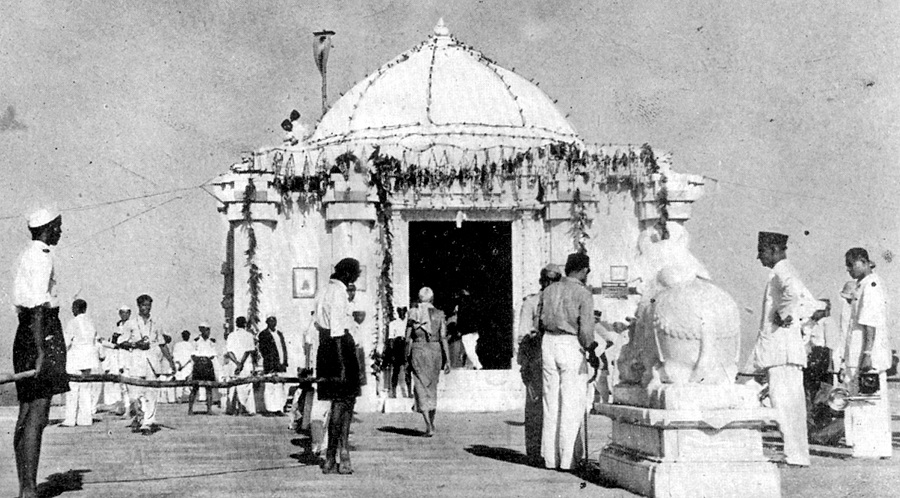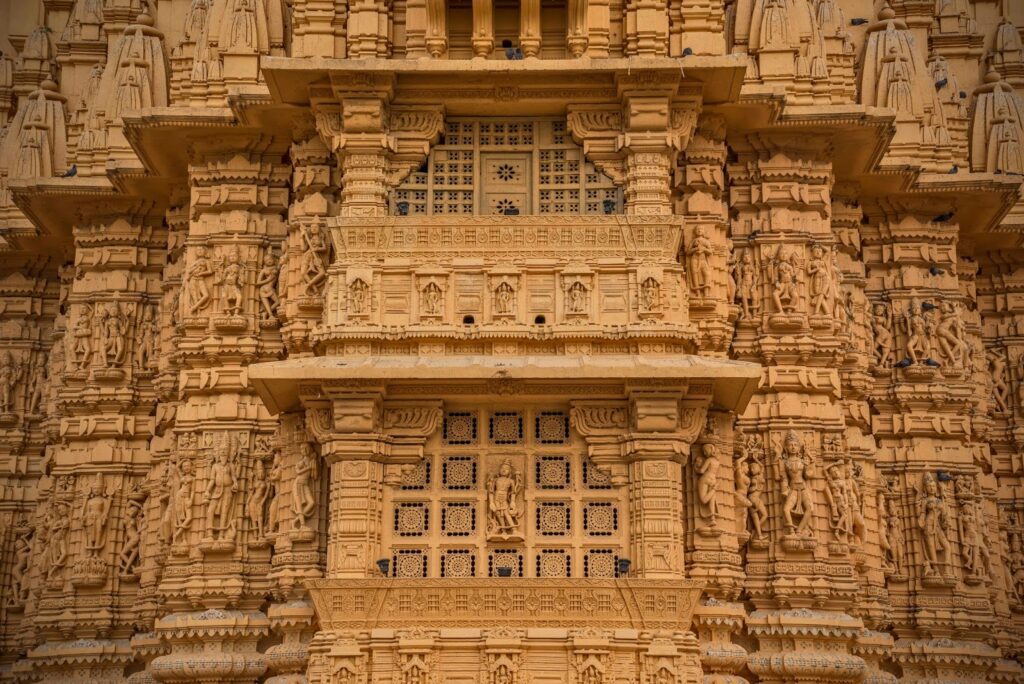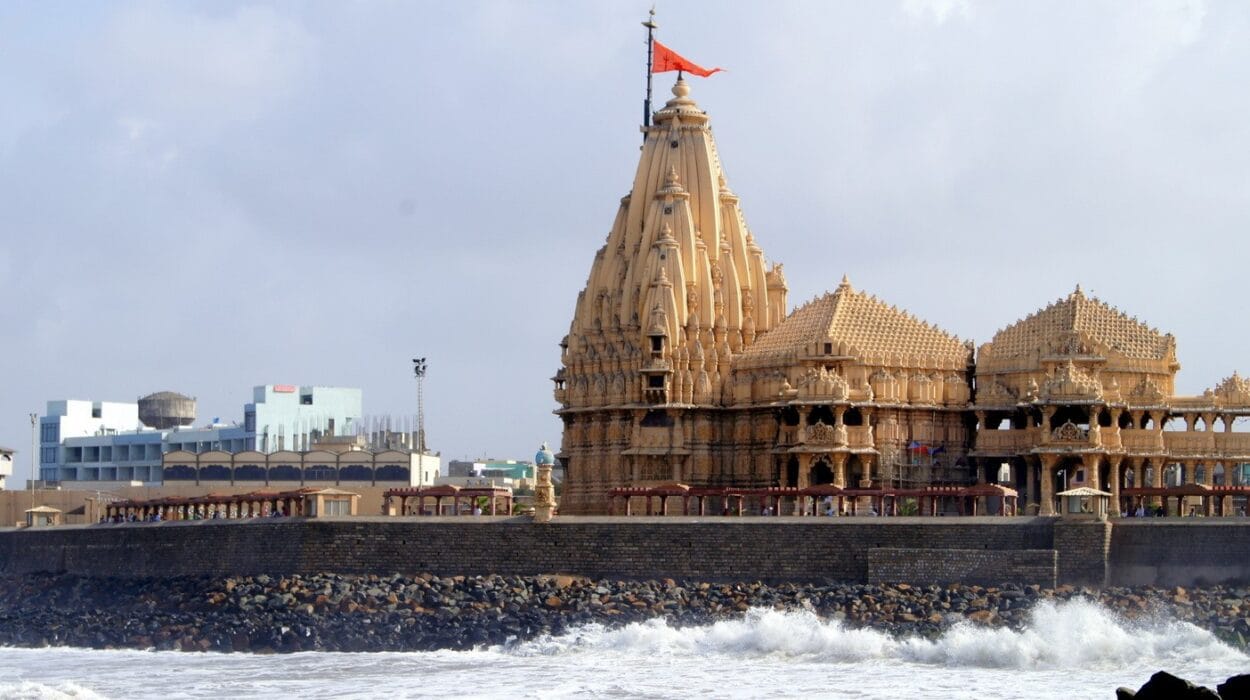In Hindu mythology and history, the Somnath Temple in the coastal town of Veraval in Gujarat, India, holds a special place. It is renowned for its rich heritage, architectural splendor, and religious significance, making it one of India’s oldest and most revered pilgrimage destinations. The temple is believed to be the first of India’s twelve Jyotirlingas, or sacred abodes of Lord Shiva, and is dedicated to Lord Shiva, one of the major Hindu deities. The Somnath Temple has been destroyed and rebuilt multiple times over its thousands-year history, and its story is intertwined with the ebb and flow of India’s diverse cultural and political landscape. Millions of pilgrims and visitors come from all over the world to see the Somnath Temple, which is now a symbol of perseverance, faith, and devotion. Let us investigate this revered temple’s religious, architectural, and historical aspects further.
Historical Background
The verifiable foundation of the Somnath Sanctuary is saturated with antiquated folklore, legends, and authentic occasions. The sanctuary’s starting points can be followed back to old times, with references tracked down in Hindu texts and sacred writings.
Hindu mythology holds that Lord Krishna, an incarnation of Lord Vishnu, performed his renowned Raas Lila, a celestial dance with the gopis (cowgirls), at Somnath. It is also believed to be the spot where Lord Shiva, the destroyer and one of Hinduism’s Trimurti (trinity) gods, appeared as the jyotirlinga, a fiery column of light that represents his divine form.
The Moon God (Chandra) is said to have built the Somnath Temple as a sign of repentance after being cursed by his father-in-law, Daksha, for favoring his other wives over Rohini, his main consort. It was believed that the temple was originally constructed of gold, silver, and precious gems. It was a grand structure that drew pilgrims from all over the world.

The Somnath Temple was favored by numerous rulers and dynasties over the centuries, including the Mauryas, Chavdas, Chalukyas, and Solankis, who contributed significantly to its construction and upkeep. The sanctuary’s riches and conspicuousness developed, and it turned into a significant focal point of journey and social trade in old India.
However, a string of invasions and destructions marred the temple’s history. Multiple foreign invaders are said to have attacked and looted it, including Mahmud of Ghazni in 1024 CE and Alauddin Khilji in 1296 CE. The Somnath Temple was rebuilt and restored by successive rulers and devotees in spite of these invasions and devastations, and it continued to be a revered place of Hindu worship.
The Somnath Temple has been rebuilt and restored numerous times in modern times. The most recent one was completed in 1951, following India’s independence from British rule. The temple attracts pilgrims and visitors from all over the world to experience its historical and religious significance as a symbol of perseverance, faith, and cultural heritage.
Architecture and Design
The Somnath Sanctuary is eminent for its stunning engineering and plan, which mirrors a mix of different compositional styles and impacts from various periods. The temple complex is spread out over a large area and consists of various sections and structures, each with its own distinctive characteristics.
The jyotirlinga, also known as the lingam or symbolic representation of Lord Shiva, is housed in the Somnath Temple’s main sanctum, or garbhagriha. The garbhagriha is a little, square-molded chamber with a taking off shikhara, or tower, enhanced with mind boggling carvings and figures. A kalash, a sacred pot-like structure, is used as the shikhara’s crown and is thought to represent prosperity and good fortune.
The mandapa, or get together lobby, of the Somnath Sanctuary is an extensive and resplendent design that highlights intricately cut support points and walls. Numerous pillars with intricate carvings of gods, goddesses, celestial beings, and mythological scenes support the mandapa. The walls of the mandapa additionally grandstand complex bas-reliefs and figures portraying different Hindu divinities and their accounts.

Another prominent aspect of the temple complex is the assembly hall, or sabha mandapa. The ceiling is exquisitely crafted and the pillars are intricately carved. The hall is large. The sabha mandapa is frequently utilized for strict social events, supplications, and services.
Friezes, sculptures, and carvings that depict scenes from Hindu mythology, legend, and historical events adorn the Somnath Temple’s outer walls. The temple’s rich artistic heritage is evidenced by these intricate carvings, which demonstrate the skill and craftsmanship of the artisans of the time.
The Somnath Temple’s overall architecture is influenced by the Solanki, Chalukya, and other ancient Indian ruling dynasties, as well as the Nagara and Dravidian styles of temple architecture. The temple is a masterpiece of Indian temple architecture thanks to its use of high-quality stone, intricate carvings, and intricate design elements.
The Somnath Sanctuary has been remade and reestablished on various occasions throughout the long term, with the most recent remaking finished in 1951 after it was obliterated during the segment of India in 1947. The temple’s design and architecture continue to awe visitors and serve as a reminder of India’s rich cultural heritage.
Religious Significance
For millions of Hindus worldwide, the Somnath Temple has a significant religious significance. It is revered as the first of the twelve Jyotirlingas, which are believed to be Lord Shiva’s most sacred abodes. It is also one of India’s holiest pilgrimage destinations.
The Somnath Temple is a place of profound spiritual significance and devotion for devoted Hindus. It is believed that going to the Somnath Temple to worship and pray can bring blessings, divine grace, and relief from the sufferings of this world. Pioneers visit the sanctuary to look for the favors of Master Shiva for wellbeing, riches, achievement, and otherworldly edification.
Several Hindu mythological tales and legends are also linked to the Somnath Temple. At the spot where the temple stands today, it is believed that Lord Krishna performed his divine Raas Lila, a celestial dance with the gopis. The sanctuary is likewise connected with the legend of the Moon God (Chandra) who is said to have constructed the sanctuary as a demonstration of atonement for his revile. The religious significance and reverence of the Somnath Temple are enhanced by these mythological tales.

The temple is also a cultural and social hub where people gather to celebrate religious and secular holidays. At the Somnath Temple, festivals like Mahashivratri, Kartik Purnima, and Diwali are celebrated with great enthusiasm, bringing in thousands of devotees and tourists from all over the country.
The Somnath Sanctuary has a rich history of support by rulers and lovers, and its remaking and reclamation after various intrusions and obliterations is viewed as an image of strength and confidence. It is viewed as a wellspring of motivation and a spot to reinforce one’s confidence in the heavenly. The temple is revered by Hindus all over the world as a place of deep spirituality and devotion because of its international significance.
In conclusion, the Somnath Temple is a sacred pilgrimage site, a place of worship, and a representation of faith, perseverance, and cultural heritage for Hindus. It keeps on drawing in huge number of travelers and guests who look for comfort, gifts, and profound edification in its blessed regions.
Destruction and Reconstruction
The Somnath Temple is a symbol of perseverance and unwavering faith because its history is marked by numerous instances of destruction and reconstruction.
According to Hindu mythology, the Moon God (Chandra) himself may have constructed the original Somnath Temple. Be that as it may, the sanctuary confronted rehashed attacks and obliteration throughout the long term by unfamiliar trespassers, including Mahmud of Ghazni, who plundered and vandalized the sanctuary in 1026 Promotion.
The sanctuary was modified and reestablished a few times by various rulers and lovers. The renowned Rajput ruler, Bhimdev I of the Solanki administration, reconstructed the sanctuary in the eleventh hundred years after it was annihilated by Mahmud of Ghazni. During the reigns of additional Solanki kings, the temple underwent additional renovations and expansions that showcase the architectural splendor of the time.

However, subsequent invasions caused additional damage to the temple, including attacks by Allauddin Khilji in the 13th century and Aurangzeb in the 17th century, both of whom destroyed the temple and stole its wealth. Regardless of these rehashed demonstrations of annihilation, the confidence of individuals in the sanctuary and its importance stayed enduring.
After India gained independence from British rule in 1947, extensive reconstruction efforts led to the construction of the Somnath Temple that it is today. The then Delegate Top state leader of India, Sardar Vallabhbhai Patel, assumed a critical part in the reclamation of the sanctuary, and it was modified under his direction fully backed up by the Public authority of India, individuals of India, and different associations.
The Somnath Temple’s reconstruction was finished in 1951, and President Rajendra Prasad dedicated it. The new temple was designed in the same way as the old one, showcasing the intricate art and culture of ancient India.
The Somnath Temple’s reconstruction is regarded as a remarkable achievement because it represents the Indian people’s unwavering faith and resilience. It demonstrates the unwavering devotion and determination to safeguard and revitalize India’s cultural heritage.
Today, the Somnath Sanctuary remains as a fabulous structure of confidence, drawing in large number of pioneers and guests from everywhere the world. It serves as a reminder of the power of faith to endure adversity and time as well as the rich history and cultural heritage of the area. The indomitable spirit of human tenacity and devotion is demonstrated by the Somnath Temple’s destruction and subsequent reconstruction.
Modern-day Status
The Somnath Temple has maintained its status as a prominent and venerated pilgrimage site for millions of Hindus today. The Shree Somnath Trust is in charge of running the temple and taking care of its day-to-day upkeep.
The Somnath Sanctuary complex has been formed into a rambling journey and social focus, offering different offices and conveniences for pioneers and guests. The sanctuary complex incorporates the principal sanctum sanctorum, as well as different altars, gardens, supplication lobbies, social focuses, and presentation corridors that exhibit the set of experiences, folklore, and compositional legacy of the sanctuary.
Visitors and pilgrims from all over India come to the temple to pray, receive blessings, and experience its divine atmosphere. The sanctuary is particularly well known during significant Hindu celebrations like Mahashivratri, Kartik Purnima, and Diwali, when it is enhanced with lights, embellishments, and merriments.

Additionally, the Somnath Temple serves as a hub for social and cultural events. The temple complex hosts a variety of cultural programs, events, and performances that highlight India’s and Gujarat’s extensive cultural heritage. Additionally, it serves as a location for social and charitable events that help the community grow and flourish.
India’s rich history, cultural heritage, and spiritual legacy are all represented by the Somnath Temple, which has also become a national pride symbol. Numerous dignitaries, including state heads and other prominent individuals, have paid homage to the temple and its significance during their visits.
The current status of the Somnath Sanctuary mirrors its proceeded with pertinence and importance in the existences of millions of aficionados and guests. It remains as a demonstration of the persevering through confidence, flexibility, and social legacy of India, drawing in travelers and guests from everywhere the world who look for comfort, endowments, and otherworldly illumination in its sacrosanct regions.
Conclusion
The Somnath Sanctuary isn’t simply a position of love, however a living declaration to the rich history, social legacy, and profound meaning of India. The temple is still standing strong today as a reminder of human perseverance, unwavering faith, and the desire to preserve and revitalize our cultural heritage despite numerous attempts at destruction and reconstruction over the centuries.
The significance of the temple in the minds of millions of devotees and visitors is highlighted by its historical context, awe-inspiring architecture, religious significance, and modern status as a revered pilgrimage site and cultural center. In addition to being a physical structure, the Somnath Temple is also a spiritual abode that fosters devotion, cultural pride, and social harmony.
The Somnath Temple continues to be a beacon of hope and faith for all visitors and pilgrims who come to receive blessings and experience its divine aura. It remains as a living demonstration of the unstoppable soul of human versatility, the influence of confidence, and the significance of protecting and advancing our rich social legacy for people in the future to come. The Somnath Sanctuary keeps on being a treasured and worshipped milestone, holding an exceptional spot in the hearts of millions of individuals who respect its holiness and track down comfort in its hallowed environmental factors.
FAQs
What is the significance of Somnath Temple?
The Somnath Sanctuary holds extraordinary strict importance for Hindus as it is accepted to be one of the twelve Jyotirlingas (sacrosanct homes of Master Shiva) in India. It is viewed as a position of incredible dedication, journey, and endowments, drawing in huge number of enthusiasts consistently.
What is the history of destruction and reconstruction of Somnath Temple?
The Somnath Sanctuary has been obliterated and remade a few times in history because of attacks and goes after by unfamiliar rulers. The sanctuary was revamped by Lord Kumarapala of the Chaulukya line in the eleventh 100 years, and later by different rulers including Mahmud of Ghazni, Allauddin Khilji, and Aurangzeb. The current sanctuary is a cutting edge remaking finished in 1951.
What is the architecture and design of Somnath Temple?
The Somnath Sanctuary shows a remarkable mix of design styles, including Chalukya, Rajput, and Solanki styles. It includes a noteworthy sanctuary complex with a great entry door, an enormous Sabha Mandap (gathering corridor), and a Garbhagriha (sanctum sanctorum) that houses the primary lingam (image of Ruler Shiva). The sanctuary is enhanced with complicated carvings, figures, and enlivening components.
What are the festivals celebrated at Somnath Temple?
The Somnath Sanctuary has different celebrations consistently, with Mahashivratri being the main one. Other significant celebrations celebrated at the sanctuary incorporate Kartik Purnima, Navratri, and Diwali. These celebrations are set apart by intricate ceremonies, reflection contributions, social projects, and a bubbly air.
How can one reach Somnath Temple?
Somnath Sanctuary is situated in the town of Veraval in Gujarat, India. It is very much associated via air, rail, and street organizations. The closest air terminal is Diu Air terminal, which is around 90 kilometers away, while the closest railroad station is Veraval Rail route Station, situated inside the town. There are additionally standard transport administrations and confidential cabs accessible for arriving at the sanctuary.







